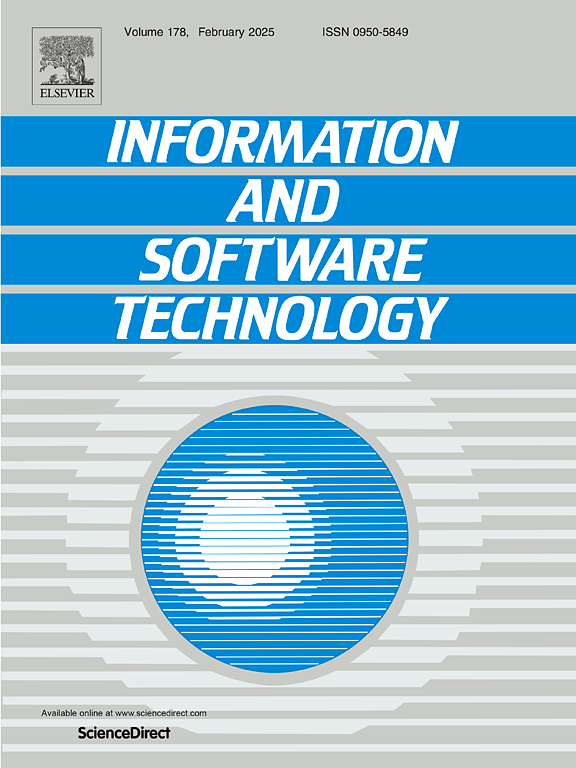DeepMig: A transformer-based approach to support coupled library and code migrations
IF 4.3
2区 计算机科学
Q2 COMPUTER SCIENCE, INFORMATION SYSTEMS
引用次数: 0
Abstract
Context:
While working on software projects, developers often replace third-party libraries (TPLs) with different ones offering similar functionalities. However, choosing a suitable TPL to migrate to is a complex task. As TPLs provide developers with Application Programming Interfaces (APIs) to allow for the invocation of their functionalities after adopting a new TPL, projects need to be migrated by the methods containing the affected API calls. Altogether, the coupled migration of TPLs and code is a strenuous process, requiring massive development effort. Most of the existing approaches either deal with library or API call migration but usually fail to solve both problems coherently simultaneously.
Objective:
This paper presents DeepMig, a novel approach to the coupled migration of TPLs and API calls. We aim to support developers in managing their projects, at the library and API level, allowing them to increase their productivity.
Methods:
DeepMig is based on a transformer architecture, accepts a set of libraries to predict a new set of libraries. Then, it looks for the changed API calls and recommends a migration plan for the affected methods. We evaluate DeepMig using datasets of Java projects collected from the Maven Central Repository, ensuring an assessment based on real-world dependency configurations.
Results:
Our evaluation reveals promising outcomes: DeepMig recommends both libraries and code; by several projects, it retrieves a perfect match for the recommended items, obtaining an accuracy of 1.0. Moreover, being fed with proper training data, DeepMig provides comparable code migration steps of a static API migrator, a baseline for the code migration task.
Conclusion:
We conclude that DeepMig is capable of recommending both TPL and API migration, providing developers with a practical tool to migrate the entire project.
DeepMig:支持库和代码耦合迁移的基于转换器的方法
背景:在开发软件项目时,开发人员经常会将第三方库(TPL)替换为提供类似功能的不同库。然而,选择一个合适的 TPL 进行迁移是一项复杂的任务。由于 TPL 为开发人员提供了应用编程接口 (API),允许他们在采用新的 TPL 后调用其功能,因此项目需要通过包含受影响的 API 调用的方法进行迁移。总之,TPL 和代码的耦合迁移是一个艰苦的过程,需要大量的开发工作。现有的大多数方法要么处理库迁移,要么处理 API 调用迁移,但通常无法同时解决这两个问题。方法:DeepMig 基于转换器架构,通过接受一组库来预测一组新的库。然后,它会查找已更改的 API 调用,并为受影响的方法推荐迁移计划。我们使用从 Maven Central Repository 收集的 Java 项目数据集对 DeepMig 进行了评估,以确保基于真实世界的依赖性配置进行评估:DeepMig 同时推荐了库和代码;在多个项目中,它检索到了完全匹配的推荐项目,准确率达到了 1.0。结论:我们得出的结论是,DeepMig能够同时推荐TPL和API迁移,为开发人员提供了迁移整个项目的实用工具。
本文章由计算机程序翻译,如有差异,请以英文原文为准。
求助全文
约1分钟内获得全文
求助全文
来源期刊

Information and Software Technology
工程技术-计算机:软件工程
CiteScore
9.10
自引率
7.70%
发文量
164
审稿时长
9.6 weeks
期刊介绍:
Information and Software Technology is the international archival journal focusing on research and experience that contributes to the improvement of software development practices. The journal''s scope includes methods and techniques to better engineer software and manage its development. Articles submitted for review should have a clear component of software engineering or address ways to improve the engineering and management of software development. Areas covered by the journal include:
• Software management, quality and metrics,
• Software processes,
• Software architecture, modelling, specification, design and programming
• Functional and non-functional software requirements
• Software testing and verification & validation
• Empirical studies of all aspects of engineering and managing software development
Short Communications is a new section dedicated to short papers addressing new ideas, controversial opinions, "Negative" results and much more. Read the Guide for authors for more information.
The journal encourages and welcomes submissions of systematic literature studies (reviews and maps) within the scope of the journal. Information and Software Technology is the premiere outlet for systematic literature studies in software engineering.
 求助内容:
求助内容: 应助结果提醒方式:
应助结果提醒方式:


